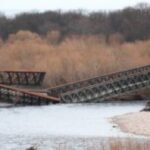A new initiative is underway to protect the A82 from landslips by planting native trees along the hillsides above Loch Ness. This stretch of road has seen closures caused by rockfalls in recent years, raising safety concerns.
Forestry and Land Scotland (FLS) has begun establishing a native woodland aimed at reinforcing the slopes, reducing erosion, and creating a natural barrier against the weather’s worst effects. The project’s first phase saw 5,000 trees planted near Drumnadrochit on previously cleared land.
Clearing Old Pines to Make Way for Native Woodland
The project involves removing some conifers—some nearly a century old—that are vulnerable to windthrow and erosion. These aging trees can easily topple, making slopes unstable and increasing the risk of landslips onto the road below.
In their place, FLS is planting a diverse mix of native species including blackthorn, hawthorn, hazel, birch, cherry, and oak. This variety isn’t random; each species plays a role in strengthening the soil and creating a resilient ecosystem.
Luke Wilson, assistant operations manager for FLS North Region, explained, “It will make the landscape – including the A82 and the infrastructure that runs alongside it – more resilient to extreme weather events that we may be seeing more of in the years to come.”
This mix of trees helps to bind the soil, soak up excess water during heavy rain, and provide windbreaks, which are essential on exposed slopes.

The Challenge of Protecting the A82
The A82 is one of Scotland’s key transport routes, running along the scenic shores of Loch Ness. But its location also puts it at risk. In recent years, landslips and rockfalls have forced closures, causing disruption for commuters and tourists alike.
Steep, exposed slopes combined with harsh weather make the area vulnerable. Heavy rains wash soil downhill, while strong winds can uproot weaker trees. Over time, this destabilizes the terrain, causing landslips that can block roads and damage infrastructure.
Planting trees is a natural solution, but it takes time to see results. The deep roots of these native species will gradually anchor the soil more firmly, reducing the chance of landslips in the future.
How Tree Planting Supports Landscape Resilience
Native woodlands don’t just protect roads. They improve biodiversity, enhance soil health, and help absorb carbon dioxide. This project fits into a broader push to restore natural habitats and boost resilience against climate changes.
In pockets of high-density planting, the saplings are carefully arranged to maximize their stabilizing effects. The initial 5,000 trees are just the start, with plans to expand over time.
-
Trees slow water runoff, reducing erosion.
-
Root systems bind soil together.
-
Dense canopy cuts wind speed and evaporation.
-
Variety of species creates a stronger ecosystem.
Here’s a quick look at why native trees outperform non-native conifers in this setting:
| Tree Type | Soil Stabilization | Climate Adaptability | Biodiversity Support | Longevity |
|---|---|---|---|---|
| Native broadleaf | High | Excellent | Supports many species | Long |
| Non-native conifers | Moderate | Moderate | Lower support | Shorter |
The shift from older conifers to native species is both ecological and practical.
What This Means for Locals and Visitors
For those who use the A82 regularly, the project promises fewer disruptions and safer journeys. It’s a long-term investment in infrastructure protection, but one that pays off by reducing costly road closures and repairs.
Locals in Drumnadrochit and surrounding areas are watching the transformation with interest. While the felled pine trees might seem like a loss at first glance, the emerging native woodland will eventually blend naturally into the landscape, maintaining the region’s beauty.
Tourists who flock to Loch Ness for its famous monster legend and stunning views might not immediately notice the changes, but the safer, greener slopes will be there for decades to come.
Looking Ahead: A Model for Future Conservation Efforts
As extreme weather becomes more frequent, projects like this set an example of how natural solutions can protect critical infrastructure. It’s a reminder that trees are more than just scenery—they are frontline defenders against environmental threats.
Luke Wilson summed it up well: “We may be seeing more of these weather events in the years to come, and it’s important to prepare the landscape now.” This project is a proactive step in that direction.
More phases are expected as FLS continues to plant and monitor the woodland’s growth, aiming to create a robust shield above the A82 that will stand the test of time.


















